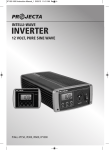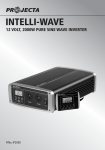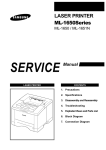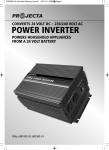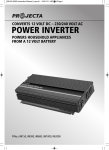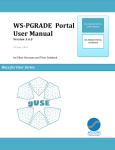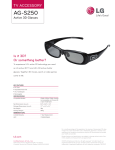Download Projecta IM150 Specifications
Transcript
PRO-WAVE INVERTER 12 VOLT, PURE SINE WAVE P/No.s PW150, PW350, PW600, PW900 & PW1800 IMPORTANT SAFETY INFORMATION Please read this manual thoroughly before use and store in a safe place for future reference. WARNINGS • • • • • • For indoor use out of weather only. For use with negatively earthed vehicles & systems only. Internally bonded for safety, battery DC negative to case & AC socket earth. Hazardous voltage inside – do not attempt to open, repair or use if damaged. Only connect 230/240V AC appliances that are in safe condition. This appliance is not intended for use by young children or infirm persons unless they have been adequately supervised by a responsible person to ensure that they can use the appliance safely. • Young children should be supervised to ensure that they do not play with the appliance. • It is recommended that a type ‘A’ portable residual current device (RCD) be used for added output protection. • For independent use, do not connect to buildings. CAUTIONS • Batteries should be mounted in a separate well-vented enclosure. • Even though the inverter is powered from a battery, it still produces dangerously high voltage AC power and has the potential to fatally injure if incorrectly installed or used. • Double check battery negative and positive posts before making any connection; a wrong connection (reverse polarity) will cause the fuse/s to blow and may damage the inverter. • A small spark (arc) can occur when making the final battery connection, this is most common when the inverter has not been used for some time. This spark is caused by the inverter’s large capacitors charging quickly. To minimise this, make the last connection quickly and completely. • Batteries can be dangerous; follow all battery manufacturer’s instructions and warnings. • Never operate the inverter without the DC negative input connected direct to the battery and never install a fuse, circuit breaker or battery switch in the negative supply line (PW150 excepted). FEATURES PURE SINE WAVE OUTPUT There are two different types of inverters, modified sine wave and pure sine wave. The difference between the two is how closely the output replicates mains power. Logically it follows that the process used in a pure sine wave inverter is more complex than a modified sine wave inverter and subsequently more expensive. Most electric appliances operate unaffected on a modified sine wave and hence they are more common. Pure sine wave inverters are best for use on medical equipment and sensitive electrical appliances. They allow you to watch television without static, play your favourite game on an XBoxTM, PlaystationTM or WiiTM and run a fluoro, all of which may not operate properly on a modified sine wave inverter. 2 FULLY ISOLATED DESIGN Safety is paramount around 240V and in particular with inverters which is why Projecta fully electrically isolates the DC (and therefore battery posts, vehicle chassis, etc) from the 240V AC circuit. DESIGNED TO AS4763 Designed in accordance with Australian Standard AS4763: 2011 – Safety of Portable Inverters. REMOTE CONTROL DISPLAY (PW600, PW900 & PW1800) The PW600, PW900 and PW1800 can connect to an optional remote (P/No. PWREMOTE) which will allow the inverter to be turned on/off remotely. Ideal for use in caravans, motor homes and boats. THERMOSTATICALLY CONTROLLED COOLING FAN PROTECTION • • • • • Low input voltage High input voltage Low battery alarm Over temperature Overload SPECIFICATIONS P/No. PW150 Input PW350 PW600 PW900 PW1800 12VDC Battery/Vehicle (10.0V–15.5VDC) Input Current (Max DC Amps) 15A 30A 60A 90A 180A No Load Current Draw 700mA 700mA 800mA 900mA 1200mA Remote Standby Current Draw – – 1mA 1mA 1mA Output 240VAC 50Hz Continuous Power (Watts) 150W 350W 600W 900W 1800W Peak Power (Watts) 300W 700W 1200W 1800W 3600W Inverter Classification Equipotentially Bonded Inverter (EPB) Output Waveform Pure Sine Wave Efficiency 85% Low Battery Alarm/ Shutdown Alarm 10.5V, Shutdown 10.0V (±0.3V) Cooling Fan Automatic Temperature Controlled Thermal Shutdown Replacement Fuse Fuse Quantity & Size Fuse Location Size (mm) Weight 65ºC (±5ºC) 3AG Glass Fuse 20A 50A (1 x 20A) (2 x 25A) Mini Blade Fuses 90A 125A (3 x 30A) DC Plug/Internal (5 x 25A) 240A (8 x 30A) Internal 196 x 126 x 67 242 x 126 x 67 339 x 190 x 81 388 x 242 x 96 391 x 266 x 116 1.0kg 1.1kg 2.7kg 4.5kg 5.1kg 3 PRODUCT OVERVIEW PW150 FRONT VIEW REAR VIEW Cigarette Plug DC Input Lead AC Output Socket L.E.D Status Indicators PRO-WAVE 150W STATUS 12V DC INPUT POWER On/Off Switch PW350 FRONT VIEW REAR VIEW Fan AC Output Socket L.E.D Status Indicators PRO-WAVE 350W + STATUS – POWER 12V DC INPUT On/Off Switch PW600 Mounting Flange 12V DC Terminals FRONT VIEW L.E.D Status Indicators Digital Display Screen REAR VIEW Fan AC Output Socket PRO-WAVE 600W VOLTS KILOWATTS + WATTS 12V DC INPUT REMOTE POWER On/Off Button – Remote Input Mounting Flange 12V DC Terminals PW900 & PW1800 FRONT VIEW Digital Display Screen L.E.D Status Indicators REAR VIEW AC Output Socket PRO-WAVE 900W VOLTS KILOWATTS WATTS 12V DC Terminals + – REMOTE POWER 12V DC INPUT 4 On/Off Button Remote Input Mounting Flange CHASSIS GND Chassis Ground Fan CONNECTING THE INVERTER PW150 The PW150 is fitted with a lead and cigarette plug. Insert the plug into the vehicle’s 12V accessory socket and turn the inverter on. You may need to turn the vehicle’s ignition to ‘accessory’ to supply power to the inverter. PW350, PW600, PW900 & PW1800 It is important to use suitable cable lengths and sizes to get the most out of your inverter. Use of cable that is too thin or too long will result in voltage drop between the battery and inverter, and may trigger low voltage warnings and inverter shutdowns. It is recommended to place cable in corrugated conduit to protect from damage. The following table lists suitable cable sizes for different cable lengths available from Projecta. Part Number (Description) Cable Length 0–3m 3–6m 2 PW350 IWK1 (3m, 8mm ) IWK2 (6m, 26mm2) PW600 2 IWK4 (6m, 49mm2) 2 IWK3 (3m, 32mm ) PW900 IWK3 (3m, 32mm ) IWK5 (6m, 64mm2) PW1800 IWK6 (3m, 49mm2) Not Recommended 1. Prepare all cable ends with cable lugs. 2. Install a circuit breaker or high current fuse and fuse holder in the positive line as close to the battery as possible. The following fuses are available from Projecta: PW350: IFB-40 (40A fuse and holder) PW600: IFB-60 (60A fuse and holder) PW900: IFB-150 (150A fuse and holder) PW1800: IFB-250 (250A fuse and holder) 3. Make sure the inverter On/Off switch is turned OFF. 4. Connect the cables to the DC input terminals on the rear of the inverter. The red terminal is positive (+) and the black terminal is negative (-). a. Connect the positive cable to the inverter and battery positive terminals. b. Connect the negative cable to the inverter and battery negative terminals. 5. The inverter is earthed through the negative DC input cable. Additional earthing can be made by connecting an insulated wired from the chassis-ground terminal at the rear of the inverter (PW900 & PW1800 only) to the vehicle’s chassis or any other ground point. FUSE CORRUGATED CONDUIT 900W Pure Sine Wave Inverter 5 OPERATING INSTRUCTIONS To operate the inverter turn the inverter On/Off switch to ON (PW150 & PW350) or press the power button (PW600, PW900 & PW1800). The inverter will beep momentarily while it carries out a brief self-analysis before supplying power to the AC socket (only on PW150 & PW350). To turn off, turn the inverter On/Off switch to OFF (PW150 & PW350) or press the power button again (PW600, PW900 and PW1800). To help prevent the inverter being overloaded: 1. Ensure appliances are turned off before turning the inverter on. 2. If multiple appliances are being run, turn on one at a time. MOUNTING INSTRUCTIONS Pro-Wave inverters are designed for indoor, out of weather use only. During operation, the inverter should be in a dry, cool and well-ventilated area as close to the batteries as possible, but not in the same compartment as the batteries. Ensure the inverter is away from flammable materials and fumes. The inverter base plate includes a mounting flange for easy mounting (excluding PW150). If permanently fixed, the inverter should be mounted to a suitable horizontal or vertical panel, with at least 10cm clearance from the end plates to provide adequate ventilation for the cooling fan. 6.5mm mounting hole Part No. 6 Length Inverter Dimensions Width Height PW150 196mm 126mm 67mm PW350 242mm 126mm 67mm PW600 339mm 190mm 81mm PW900 388mm 242mm 96mm PW1800 391mm 266mm 116mm UNDERSTANDING YOUR INVERTER A) PW150 & PW350 These inverters are equipped with two status L.E.D’s and audible alarm. During normal operation, the green L.E.D will illuminate solid green. In the event of a fault or error, the alarm will sound and the red L.E.D will illuminate. STATUS L.E.D SIGNAL ALARM Normal Green – Low Battery Voltage Green ON Low Battery Voltage Shutdown Red ON Over Temperature Shutdown and Output Short Circuit Red ON Overload Shutdown Red ON High Battery Voltage Shutdown Red ON B) PW600, PW900 & PW1800 These inverters are equipped with an audible alarm and a multi-function L.E.D display During normal operation, the L.E.D display will alternate between Volts and the load being drawn measured in Watts or Kilowatts. VOLTS: Displays input battery voltage WATTS: Displays the amount of power being drawn by the appliance (in Watts) KILOWATTS: Displays the amount of power being drawn by the appliance (in Kilowatts) In the event of a fault or error, the alarm will sound and the L.E.D screen will display one of several fault codes. Description of L.E.D and Digital Display Codes L.E.D Digital Display Description Green 13.5 Example: 13.5V Alarm On Off Yellow 1.00 Example: 1.00Kw (1000W) Off Red 500 Example: 0.5Kw (500W) Off LUP Low voltage alarm On LUP Under voltage shutdown On OUP Over voltage shutdown On OLP Over load shutdown On OCP Over temperature shutdown On OPP Short Circuit On Restarting after an AC Output Shutdown 1. Press the unit’s power switch to turn it off. 2. Remove all AC loads or let the unit cool down for 15 minutes. 3. Press the unit’s power switch to turn it on. 7 Input Voltage The input voltage limits are shown in the following table. Operating condition Voltage range Comments Normal 11.0V – 14.0V – Peak performance 13.0V – 14.0V – Low voltage alarm 10.5±0.3V The audible low battery alarm sounds. Low voltage shutdown 10.0±0.3V The unit shuts down to protect the battery from being over-discharged. High voltage shutdown Voltage is 15.5V or more The unit shuts down to protect itself from excessive input voltage. Note: Although this incorporates over-voltage protection, it can still be damaged if input voltage exceeds 16V. Unit restarts after low voltage shutdown 11.6±0.3V The unit will not restart unless the battery voltage is acceptable for running the load. REMOTE CONTROL An optional remote can be purchased for the PW600, PW900 and PW1800, P/No. PWREMOTE. To install the remote control, insert the plug into the data socket on the front panel. The remote has the ability to turn the inverter on and off remotely and indicate when the inverter is on. TROUBLE SHOOTING Problem LUP Possible Cause Poor DC wiring and/or poor battery condition OUP Over-voltage(high input) shutdown OLP Overload shutdown OCP Over-temperature shutdown OPP Short circuit No output voltage; no voltage indication The unit is off No power to the inverter Inverter fuse is open Reverse DC polarity 8 Solution Use proper cable and make secure connections. Charge the battery or install a new battery. Make sure the inverter is connected to a 12V battery. Reduce the load within the inverter’s continuous power rating. Improve ventilation and make sure the inverter’s ventilation openings are not obstructed. Reduce the ambient temperature, if possible. Check the AC wiring for a short circuit. Turn the inverter on. Check wiring to the inverter. Have a qualified service technician check and replace the fuse if necessary. Have a qualified service technician check and replace the fuse, making sure to observe correct polarity. UNDERSTANDING YOUR POWER REQUIREMENTS POWER REQUIREMENTS OF YOUR APPLIANCE/S: All appliances have a rating plate that shows the amount of power (Watts) used or the current (Amps) drawn under normal use. The following table shows the maximum combined AC Watts or AC Amps which can be run by the inverter. P/No. PW150 PW350 PW600 PW900 PW1800 AC Combined maximum load (Watts) 150W 350W 600W 900W 1800W AC Combined maximum load (Amps) 0.6A 1.4A 2.4A 3.6A 7.2A Some appliances that use an electric motor or transformer may draw up to 10 times their power rating when first turned on. These are called inductive loads and are the most difficult for the inverter to run. Contact your appliance manufacturer for further advice. SUITABLE POWER SOURCE In order to operate the inverter and supply power to an appliance a suitable 12V DC power supply is required, typically a vehicle or caravan battery, portable power pack or an independent 12V lead acid battery. For most applications, a deep cycle battery is recommended for best performance. The size of the battery used will determine how long the inverter will supply power to an appliance and how well the inverter will perform. Most batteries are marked with their size in Amp hours (Ah) or Cold Cranking Amps (CCA). Because 12V inverters are capable of drawing high currents the inverter should only be connected to a suitable size battery. Connection to an undersized battery could damage the battery and will result in the inverter shutting down within a short period due to low battery voltage. The amount of power drawn from the battery is proportional to the inverter load. P/No. PW150 PW350 PW600 PW900 PW1800 17Ah (100CCA) 24Ah (200CCA) 50Ah (400CCA) 75Ah (550CCA) 85Ah (600CCA) Run time with maximum load and minimum battery size 40 min 40 min 30 min 15 min 5 min Run time for a 100W globe with minimum battery size 80 min 2 hours 4 hours 6 hours 7 hours 50–70Ah 50–70Ah 50–130Ah 75–250Ah 85–400Ah Minimum recommended battery size Ideal battery size 9 TROUBLESHOOTING/FAQ: Q. Why does the inverter turn itself off? A. If the inverter’s audible alarm sounds and a fault L.E.D illuminates, this indicates that there is a fault or error, and the inverter may turn off. Most commonly this would be caused by an appliance that is drawing too much power (overloading), low battery voltage or voltage drop due to insufficient size cables or poor connections (refer to 'Understanding your Inverter' tables, page 7). Q. The Inverter will not run my appliance even though the appliance draws less power (Watts) than the size of the inverter? A. Electrical appliances can be divided into three groups by the way they draw energy (current) from their power supply. These groups are “Resistive”, “Inductive” and “Capacitive” appliances or also called “loads”. Some appliances may draw all three types of power. Resistive Loads such as normal incandescent lights (wire filament) always draw a constant power (watts) from the power supply, that is a 100 Watt light will draw approximately 100 Watts from the power supply at all times. Resistive loads are the easiest appliances for an inverter to run. Inductive Loads such as a refrigerator (Electric Motor) require a large rush of power (surge current) to start and then usually draw a more constant power once running. Inductive loads contain coils of wire (motors, transformers, ballasts, solenoids). When the power is first turned on, these coils of wire draw a large surge current which forms the magnetic flux (magnetic field) which allows these appliances to work. This magnetic flux is a kind of stored energy. The most common inductive appliances are: fridges, air compressors, transformers/ chargers, pumps, power tools and fluorescent lights. These appliances can draw up to 10 times their normal running power to start up; that is to run a 80W fridge you may need a 600 or 1000 Watt inverter. Capacitive Loads such as many TV’s or many electronic appliances require a large surge current to start only when they have not been used for a while. This is often due to large capacitors in the power supply that must be quickly charged when the appliance is turned on. If the appliance is not used for a few days these capacitors slowly go flat. Resetting the inverter a couple of times may allow these appliances to work. There are some appliances such as large refrigerators, air conditioners and other pump driven appliances that have extremely high start up currents, because they have an inductive motor that must start under load. These appliances are not recommended for use with an inverter. They should be powered by an engine driven generator. Q. Why does it damage the inverter if the battery leads are reverse-connected? A. Your inverter uses sophisticated electronics to convert DC battery power to AC mains power. If you accidentally connect the inverter to the battery incorrectly (reverse polarity) a large current will be drawn by the inverter which will blow the protection fuse. As this occurs some of the high current could damage sensitive electronic components. Because of this risk it is important to always double-check the battery polarity before making any connections. 10 Q. How do I check or change the fuses? Pro-Wave inverters contain internal fuses and should only be checked or replaced by a qualified electrical appliance repairer. THE DC SUPPLY MUST BE DISCONNECTED BEFORE ANY REPAIR, THEN TURN THE ON/OFF SWITCH OF THE INVERTER “ON” TO DISCHARGE THE CAPACITORS. Q. Why does the fan only operate sometimes? A. Pro-Wave inverters feature a temperature controlled automatic cooling fan that only operates when needed. This allows the inverter to run very quietly for most of the time. Q. Can I run laptop computers and other sensitive electrical appliances? A. Yes. Pro-Wave’s pure sine wave output is suitable for medical equipment and sensitive electrical appliances. They allow you to watch television without static, operate computers and gaming consoles and run fluorescent lights. 11 WARRANTY STATEMENT Applicable only to product sold in Australia Brown & Watson International Pty Ltd of 1500 Ferntree Gully Road, Knoxfield, Vic., telephone (03) 9730 6000, fax (03) 9730 6050, warrants that all products described in its current catalogue (save and except for all bulbs and lenses whether made of glass or some other substance) will under normal use and service be free of failures in material and workmanship for a period of one (1) year (unless this period has been extended as indicated elsewhere) from the date of the original purchase by the consumer as marked on the invoice. This warranty does not cover ordinary wear and tear, abuse, alteration of products or damage caused by the consumer. To make a warranty claim the consumer must deliver the product at their cost to the original place of purchase or to any other place which may be nominated by either BWI or the retailer from where the product was bought in order that a warranty assessment may be performed. The consumer must also deliver the original invoice evidencing the date and place of purchase together with an explanation in writing as to the nature of the claim. In the event that the claim is determined to be for a minor failure of the product then BWI reserves the right to repair or replace it at its discretion. In the event that a major failure is determined the consumer will be entitled to a replacement or a refund as well as compensation for any other reasonably foreseeable loss or damage. This warranty is in addition to any other rights or remedies that the consumer may have under State or Federal legislation. IMPORTANT NOTE Our goods come with guarantees that cannot be excluded under the Australian Consumer Law. You are entitled to a replacement or refund for a major failure and compensation for any other reasonably foreseeable loss or damage. You are also entitled to have the goods repaired or replaced if the goods fail to be of acceptable quality and the failure does not amount to a major failure. Distributed by AUSTRALIA Brown & Watson International Pty Ltd Knoxfield, Victoria 3180 Telephone (03) 9730 6000 Facsimile (03) 9730 6050 National Toll Free 1800 113 443 NEW ZEALAND Narva New Zealand Ltd 22–24 Olive Road PO Box 12556 Penrose Auckland, New Zealand Telephone (09) 525 4575 Facsimile (09) 579 1192 IS278 Issue 1 7.04.14












